Not everyone has made it to the top school-leaving certificate. But just because you might not have had much desire to learn at school for a while, you don’t have to give up your dream of studying fashion. You can also do fashion design, fashion management, clothing technology, and much more without a high school diploma.

In the past, however, especially at universities, studies were usually reserved for high school graduates. Fortunately, those times are over and the system has become more permeable. Even those who dropped out of school without a degree can make it through with hard work.
What does a Fashion Designer do?
As a fashion designer, you design clothes and accessories for companies or you design fashion lines under your own name.
To exercise this profession, it is essential to be passionate about fashion, but also to always be:
- On the lookout for the latest trends: A designer’s job is to carry out competitive intelligence to keep abreast of what other brands are producing, but also to take a more general interest in trends in society in matters of art, decoration, etc. Therefore, they should always be informed of the latest trends.
- Creativity: Your mission is to invent collections several times a year. These collections will attract future clients and are not comparable to work already done. With the next creation, the stylists and designers must be very creative and always be full of creativity.
- Versatile: When you work under the orders of an artistic director, it is your responsibility to adhere to the specifications or spirit of the brands you serve. A designer may have to work on both clothing and accessories. They must therefore demonstrate adaptability and versatility to respond to the various demands and requests from their management and from clients, even if their visions of fashion do not correspond to the designer’s own.

The Fashion Design Career Path
In the fashion design industry, in particular, a degree is not a prerequisite for a successful career. We’ll show you tips with which you can gain a foothold even without studying.
You don’t need to take a specific course or pocket a degree to become an accomplished fashion designer, but that doesn’t mean it will be easy. To become a fashion designer, you must know how to draw, sew and design clothes, but also be familiar with the world of fashion and show unfailing perseverance. You should also create a good portfolio of your creations and strengthen your knowledge of business management and finance in general.
“You should know the general and specific requirements, have strong basic skills, and a true desire to become a fashion designer”, Joan Young, an academic writing expert said on her blog. Joan Young is an aspiring journalist and essay writer with a keen interest in invention, technological advancements, and the fashion industry.

Be Objective
You need to honestly assess your skills and personality before beginning a career in the fashion world. You may love clothes, but clothes are only part of the equation of a clothing house. Here are some of the personality traits a fashion designer needs:
- excellent communication skills
- ability to work very hard (often 24/7)
- ability to hear and accept criticism
- dealing with stress
- openness to interact with your clients and/or bosses
- willingness to accept loneliness or isolation from time to time (depending on how you will run your business and career)
- ability to be disciplined and willful.
You are certainly made to become a fashion designer if you:
- want to devote your life to this career (it is your “vocation”),
- are not afraid of uncertainty or insecurity
- are ready to defend what you believe in,
- have very specific ideas about the most important things in fashion
- are customer-oriented
- know almost everything about fashion.
This career won’t be for you if you:
- don’t know how to handle stress
- don’t like uncertainty or instability
- want a career without too many ups and downs
- need other people to complement your efforts
- need a lot of help and guidance in your job
- hate being financially unstable
- have many interests.
Learn about the Fashion Industry
Being a successful fashion designer requires not only talent and creativity but also good knowledge of the business and marketing aspects of this economic sector. You must therefore inform yourself daily about current events in the fashion world by regularly reading specialized magazines like Vogue, etc.

Don’t stop at design. There is a whole supply chain in the fashion industry, and you need to understand what each person’s role and tasks are so that you can embrace their perspectives, know how to compromise, respond to their demands and understand the blockages that can occur. Learn about what your partners are doing, such as buyers, dealers, pattern cutters, garment and fabric technologists, quality controllers, graders, machinists, salespeople, public relations, and individuals in charge of marketing, fashion journalists, retailers, event planners, stylists, etc.
Know your customers. This skill is important, and you should always remember it. Know how much your customers are spending, what their lifestyles are, where they like to shop, how they shop and what they like and don’t like to wear, etc. You also need to know their basic needs and the parts they only buy when their income allows them. If you’ve been marketing, you should have a solid understanding of how you can leverage your customer’s needs to your advantage.

Make yourself familiar with the competition. Always keep an eye out for other designers in your industry. At a minimum, try not to get left behind. But the best is to surpass them while continuing to meet the needs of your customers.
Trade shows are a great place to gain a better understanding of how the fashion industry works and the needs of your customers – two essentials that will keep you competitive.
Find a Job as a Fashion Designing Expert
There are different ways to find a job in the fashion industry as a designer, and it usually depends on the industry you are interested in. In some cases, being versatile will allow you to stand out, find the first job before creating your own brand in the near future. In most cases, however, you will need to be persistent and submit your application many times before the doors start to open. Here’s where to start for beginners.
- Clothing houses and fashion designers: look for an internship, a junior position, an assistant position, etc.
- Costume designer jobs in movie studios, theaters, specialty stores, etc.
- Online ads on job search platforms.
- Word of mouth: ask coworkers and contacts to help you get into a home. In this environment, priority is given to well-positioned people, which you can also take to your advantage.

Create Your Portfolio
It is an essential tool that will support your application for a position or an internship in the field of fashion because it allows you to highlight your work and your talent. Your portfolio should show off your finest creations and highlight your skills and creativity. Use a quality filing cabinet to be taken seriously. Remember to include the following.
- Original or photographed versions of your designs.
- Your designs are made through assisted design programs.
- Your “mood” or “concept” page.
- A page showing the colors or fabrics you use.
- The coins show what you are capable of doing and in what environment you will be able to evolve.
Develop Your Skills
Successful fashion designers have many skills including drawing, a keen eye for colors and textures, and the ability to see objects in three dimensions, as well as mechanical skills such as sewing and cutting fabrics.
Take a sewing class if you haven’t mastered the technique yet. Knowing how to sew more complicated fabrics in difficult situations will save you in many situations throughout your career, and you can always improve. Indeed, knowing how to sew is not always easy for some people.

Understand how fabrics move, drape, breathe and govern when worn, etc. Your knowledge about the different fabrics is absolutely necessary for the design of your clothes. You also need to know where to find quality fabrics.
Learn from more experienced designers. Don’t just know who they are, but also their background, their style, the studies they took, and the institutions they attended. All this knowledge allows you to become a better couturier too because you can draw inspiration from their ideas and experiences.
Learn how to create your own storyboards and product lines. Familiarize yourself with researching new trends in the media, on online shopping sites, and in fashion shows.
Start developing these new skills at a young age. Prepare to dedicate many hours to perfecting your talent. You will be able to deepen your understanding of the fashion world a little each day if you plan to make it your career. Do not try to accomplish everything at the same time, as you may become discouraged.
Identify Your Area of Interest
You may have to start at the bottom, but you need to establish your goals to determine which fashion-related field you want to grow into throughout your career. Are you interested in high fashion, ready-to-wear, sports/leisurewear, wholesale, or niches like eco-friendly clothing design?

Each area has its advantages and disadvantages that you are going to have to explore before making your final decision. In these major areas, you will also need to refine the sub-area that interests you most. You may want to explore several, but to begin with, avoid spreading yourself too thin as it is best to hone your skills in one area and then experiment when you already have a stable foot in it.
Consider for example:
- women’s day wear or evening wear,
- men’s day wear or formal wear,
- clothes for little boys, girls or teenagers,
- sports or leisure clothing,
- sweaters and wool work,
- outerwear, adventure clothing or coats,
- wedding outfits,
- the accessories,
- casual outfits,
- costumes for film or theater, the entertainment industry, and retailers.
Ask Your Customers What They Want
Be realistic: if you live in a very hot country, you will have a hard time selling ski jackets. Look around you. What does Mr. and Mrs. Everyone need? For example, if you plan to design a complete collection, you will need to draw more tops than bottoms, as this is what is usually found in the wardrobe of ordinary people. Tops are a great way to change up your look easily, while nice, tailored pants can often pair with most of your tops. Keep it simple and grounded in reality. Extravagant sketches look gorgeous on paper, but cute tops and pairs of jeans will sell far more than evening dresses.
Get Inspired by Your Competitors
Observe and note the fabric they use, the zipper size (to make their clothes resistant to wear and tear), the quality of the fabric, and their properties such as waterproofs, comfort, ventilation, or care needed, which colors are selling in your country, etc. By studying your competition, you can inspire yourself (not copy). By taking the best of each piece you analyze, you will understand what makes a collection successful. Pay attention to the parts that sell the best. Your customers (whether they are buyers for retail spaces or ordinary consumers) especially want to find rooms in which they feel beautiful. The extravagant pieces are worn only a few days of the year. They are therefore essential.
Design Your Strong Pieces
What is your greatest strength? You might be very good at designing accessories or drawing yoga pants. Your passion and your skill are an essential first part of the equation. Of course, the second part corresponds to what the market wants, the latest trends, in order to know the market in which you are part of and to be able to influence it by imposing your paw.
About the author:
Joan Young is an aspiring journalist, copywriter and professional essay writer from AdvancedWriters with deep interest in sociology, inventions and technological progress. In a spare from travelling minute, she provides online tutoring sessions to international students and finds immense pleasure in witnessing their writing progress. Some of her insights can be found in her author’s column on the blog.

Anika Sachdev is a freelance writer, who writes about fashion and lifestyle. She is currently pursuing her diploma in Fashion Design from iNIFD. She enjoys styling, making fashion illustrations and is a big fan of the work of Coco Chanel. Based in Mumbai, she likes to draw and listen to Bollywood music in her free time. For any questions, feedback or concerns, please email [email protected].